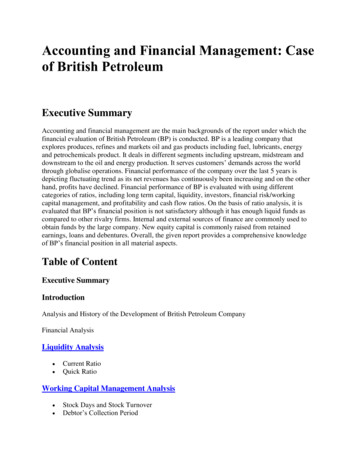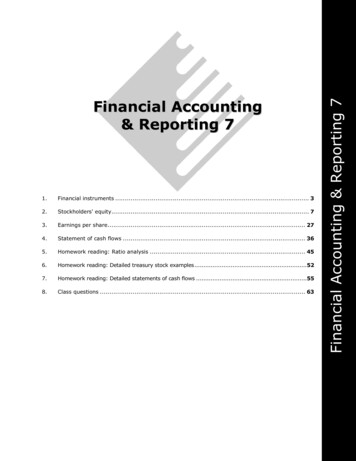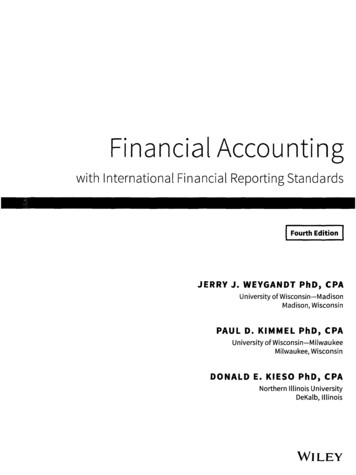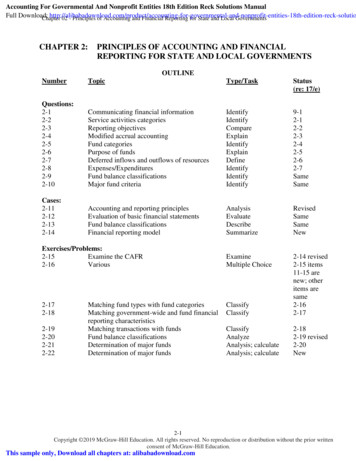
Transcription
Accounting and Financial Management: Caseof British PetroleumExecutive SummaryAccounting and financial management are the main backgrounds of the report under which thefinancial evaluation of British Petroleum (BP) is conducted. BP is a leading company thatexplores produces, refines and markets oil and gas products including fuel, lubricants, energyand petrochemicals product. It deals in different segments including upstream, midstream anddownstream to the oil and energy production. It serves customers’ demands across the worldthrough globalise operations. Financial performance of the company over the last 5 years isdepicting fluctuating trend as its net revenues has continuously been increasing and on the otherhand, profits have declined. Financial performance of BP is evaluated with using differentcategories of ratios, including long term capital, liquidity, investors, financial risk/workingcapital management, and profitability and cash flow ratios. On the basis of ratio analysis, it isevaluated that BP’s financial position is not satisfactory although it has enough liquid funds ascompared to other rivalry firms. Internal and external sources of finance are commonly used toobtain funds by the large company. New equity capital is commonly raised from retainedearnings, loans and debentures. Overall, the given report provides a comprehensive knowledgeof BP’s financial position in all material aspects.Table of ContentExecutive SummaryIntroductionAnalysis and History of the Development of British Petroleum CompanyFinancial AnalysisLiquidity Analysis Current RatioQuick RatioWorking Capital Management Analysis Stock Days and Stock TurnoverDebtor’s Collection Period
Creditor’s Collection PeriodLong Term Gearing Capital GearingInterest Coverage RatioCash Flow Ratios Operating cash flow to maturing obligations ratioFree cash flow ratioProfitability ratios Gross Profit MarginReturn on Capital EmployedInvestment Ratios Earnings per share (EPS)Source of Finance Key Areas to be consideredAim and Purpose of Obtaining FinanceFactors Considering for the Source of FinanceBP and Sources of FinanceConclusionReferenceAppendix Ratio CalculationBalance SheetIncome StatementCash Flow StatementIntroduction
The given report is based on the rigorous financial analysis of British Petroleum (BP) over thefinancial period of 2011 to 2012. Financial analysis of the company is done on the basis of therelevant financial ratios to evaluate BP’s position in respect to liquidity, working capitalmanagement, profitability, long term capital and cash flow. Review of this report provides agood overview of the financial position of the company from the investment viewpoint. Inaddition to this, aims and objectives of getting finance, factors taken into account related to thesource of finance, key areas considered for getting loan and selection of the appropriate source offinance are also being included in the report. The report covers the history and development ofBP, financial analysis, sources of finance and lastly, the conclusion.Analysis and History of the Development of BritishPetroleum CompanyBP is a renowned company in the major integrated oil & gas industry, which serves fuel,lubricants, energy and petrochemicals product. In all the related areas, the company deals tomaintain its eminent image including exploration, production, refining, marketing anddistribution of oil and gas along with power and petrochemicals production and marketing (BP2013). There are three main segments within which the company operates including upstream,midstream and downstream. In the upstream segment, BP is involved in the production, fielddevelopment and exploration of oil and natural gas.Main operations performed under the upstream activities are offshore platforms, processingfacilities and wells and pipelines. In around 30 countries, namely India, Russia, Tobago,Norway, Angola, Brazil, Azerbaija, etc., BP Company operates upstream activities. On the otherhand, the midstream segment is engaged in the natural gas (natural gas liquids and liquefiednatural gas) storage, processing, marketing and trade. Downstream segment of the company isengaged in the petroleum and petrochemicals products related process including refining,manufacturing, transportation, marketing and trade. The operational activities in the downstreamsegment are furnished at Asia, North America and Europe. In the world, 15 refineries are ownedby BP as per the recent figures of 2013. BP initiated its operations in 1889 and is located inLondon, UK. Currently, BP works with 85700 employees to serve the demand of petroleum,natural gas, motor and aviation fuels throughout the world (BP 2013). Position of BP in thisindustry is quite good as it efficiently focuses towards social and environmental issues,stakeholder engagement and transparency in operations. In this context, the company ispositioned on 1st rank as per ‘Tomorrow Value Rating’ (Oil and Gas 2011). Overall, BPCompany gives more emphasis on the corporate social responsibility for the welfare of thesociety and economy as a whole.As per the 5 year trend, net revenues/sales of the company decreased during 2008 to 2009 i.e.196.99 bn to 153.32 bn respectively due to the financial crisis. Later, in the following years,revenues have shown an increasing trend, it was 192.44 bn in 2010, 234.44 bn in 2011 and
237.02 bn in 2012. Despite increased sales, the net income of the company declined during thesame period. It was 11.5 bn in 2008 that reduced to 10.6 bn 2009, -2.41 bn in 2010, 16.03 bnin 2011 and 7.31 bn in 2012 (BP Plc ADS 2013). This exhibits that year on year, BP’s netincome decreased and its profitability got affected. On an average, the growth rate divided overthe last 5 years equals to -4.84%, but dividend per share increased to 17.86% (BP Plc 2013). Thepositive trend of dividend payment is a good symbol for investment in the oil and gas industry.Overall, the financial position of BP is showing positive results which are evident from the yearon year growth.Financial Ratio AnalysisDetailed analysis of each ratio is explained under and their calculation part has been included inappendix.Liquidity AnalysisLiquidity ratio shows the company’s ability to pay its short term obligation/liabilities. Thecommon ratios used to determine the liquidity position are Current ratio and Quick Ratio.Generally, higher the liquidity ratios are, higher the margin of safety and it shows the company’sposition to meet its current liabilities.(a) Current RatioRatio of Bp and other industry competitorsRatioCurrent ratioQuick Ratio20121.451.0720111.160.84Competitors (Chevron Corp)1.631.25(Chevron Corp – CVX 2013)(Refer appendix (i)
The current ratio is the ratio between current assets and current liabilities. Current Ratio indicatesthe company’s ability to convert the current assets into cash and cash equivalents quickly so thatthe current liabilities can be paid off at time (Brigham and Ehrhardt 2011). On analysing thecurrent ratio of BP, it can be concluded that in the year 2011, the results were not satisfactory butin the year 2012, the company showed some progress in maintaining good amount of currentassets to pay its liabilities. The ratio of the company in 2011 was 1.16 and in 2012, it was 1.45.Therefore, the company’s liquidity position as compared to the ideal benchmark is notacceptable.On comparison with the other industry competitors, the ratio of BP shows unsatisfactory figures.This indicates that the company is working less efficiently in comparison with other industryleaders. The increase in the current ratio of the company was due to an increase in workingcapital in 2012.(b) Quick RatioQuick Ratio, also known as Acid Test ratio, is another type of ratio that is used to measure theliquidity position of the company. This ratio is similar to the current ratio but the only differenceis that current assets do not include inventory and prepaid expenses. The reason for not includinginventory is that many businesses are not able to convert the inventory easily. So, it is difficult tocompare companies that maintain low level of inventory, like service sectors (Brigham andEhrhardt 2011).The acid test ratio of BP Corporation stood at 0.84 in the year 2011 and it increased by 27 % tobe at 1.07 in the year 2012. The large gap between the current asset and quick asset ratiosindicates that the company uses its inventory to derive its liquidity. Therefore, the companyachieved the ideal benchmark of 1:1 in 2012.On comparing with competitors’ ratios, results of BP Corporation are slightly low, which showsthat competitors maintain more inventory level than BP Corporation. One of the negativeimpacts on a company with lower acid test than that of the industry and/or competitors is that
lenders and creditors are likely to prefer dealing with other players in the industry as compared tothat company. Thus, it is difficult to convince lenders and creditors for short term purposes.In summary, the liquidity position of the BP Corporation reflects inadequate results than itscompetitors. It is advisable to BP Corporations that it should increase its investments in the shortterm assets that will help the company to increase the proportion of liquidity driven by moreliquid assets. Hence, it will increase both current and quick ratio.Working Capital Management AnalysisFor any business, working capital management is one of the significant factors to maintain theproper flow of entire production process. It refers to the effective management of the company’sworking capital or assets required to run the business on daily basis (Sagner 2010).Ratios of Bp and other industry competitorsRatioStock Turnover RatioStock DaysDebtors collection periodCreditors payment period201213.5127 days35 days58 days201114.0426 days41 days67 daysCompetitors (Chevron Corp)24.0915.15 days32.27 days58.24 days(Chevron Corp – CVX 2013)(Refer appendix (ii))(a) Stock Turnover Ratio and Stock DaysStock turnover ratio reflects the speed of movement of inventory outside the company so as togenerate sales, whereas stock days show the number of days for the inventory to be sold out andrestocked (Sagner 2010). The stock turnover ratio of BP Corporation was 14.04 % in FY 2011which decreased by 3 % to be at 13.51 % in FY 2012. This indicates that there is no significantchange in the inventory level in the present year. On looking at the stock days, which is 26 days
in FY 2011 and 27 days in FY 2012, indicate that the company can sell its inventory in about amonth, but it is not upto the desired level.On comparing both ratios with competitors in the market, the results are totallyunsatisfactory. The stock turnover ratio of competitors was 24.09 % which indicates that BPCorporation is not able to convert its stock in cash as fast as its competitors. Comparing the stockdays with competitors, i.e. 15.15 days, show that BP Corporation is not working effectively.(b) Debtor (Receivables) collection periodDebtor collection period states the capability of the company in turning out its receivables intocash so as to meet its current liabilities. This also leads to improve the liquidity position of thecompany (Bull 2007). Debtor collection period of BP Corporation in FY 2011 was 41 days,which was reduced by 6 days in FY 2012 i.e. 35 days. This significant decrease in the collectionperiod was due to the new policy adopted by the company to collect its receivables more quickly.(c) Creditors Payment PeriodCreditor’s payment period ratio is used to calculate the number of days taken by the company topay its creditors for the amount of purchases made (Bull 2007). BP Corporation payment periodwas 67 days in FY 2011, which decreased to 58 days in FY 2012. The decrease in paymentperiod was mainly due to the decrease in receivables collection period.Compared to competitors (58.24 days), BP Corporation was not effective in 2011, but in 2012,there was a significant decrease in the payment time that made the company to stand with othercompetitors.Long term capital RatiosLong term capital or gearing ratio indicates the percentage of debt in the company’s capitalstructure. So higher the gearing ratios, higher is the financial risk. The company has to pay theinterest amount on the borrowed amount regardless of any revenue. Therefore, at the time offinancial crises, the company is not able to pay its financial charges and has to use its retainedearnings, or otherwise the company gets into the position of bankruptcy (Bull 2007).Ratios of Bp and other industry competitorsRatioCapital gearing ratioInterest Cover ratio201246.51 %17.54 times201146.34 %31.95 timesCompetitors (Chevron Corp)10.80 %
(Chevron Corp – CVX 2013)(Refer appendix (iii))1. a) Capital Gearing RatioCapital gearing ratio calculates the amount of geared part (Long term debt) in the total capitalemployed. It is the measure of degree of financial leverage, indicating the degree to which acompany’s activities are funded by owner's funds against outsider’s funds. BP Corporation’scapital gearing ratio was 46.34 % in FY 2011 and 46.51 % in FY 2012. On comparing with thesame industry competitors, which have the gearing ratio of 10.80 %, it can be concluded that thecompany has taken more loan amount. This indicates that the BP Corporation is at more financialrisk as compared to other key players (Bull 2007).(b) Interest Coverage ratioInterest coverage ratio helps to calculate the company’s ability to pay its interest expenses.Higher the coverage ratio, lower the financial risk (Bull 2007). The interest coverage ratio of BPCorporation was 31.95 times in FY 2011, which was decreased by 45 % in FY 2012 with 17.54times. The decrease in the coverage ratio attributes to increase the long term liabilities anddecrease the EBIT.In the nutshell, it can be concluded that the leverage position of the company is not asgood as it should be. The company has a sufficient amount of profit to
The given report is based on the rigorous financial analysis of British Petroleum (BP) over the financial period of 2011 to 2012. Financial analysis of the company is done on the basis of the relevant financial ratios to evaluate BP’s position in respect to liquidity, working capital management, profitability, long term capital and cash flow. Review of this report provides a











